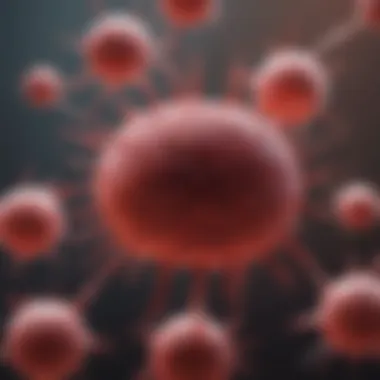HIV and Chemotherapy: Implications for Treatment


Intro
The interaction between Human Immunodeficiency Virus (HIV) and chemotherapy is a critical area of medical research. As more patients with HIV are diagnosed and treated for cancers, understanding the implications of chemotherapy on these individuals is paramount. This section will present insights into the complexities involved in treating co-infected patients and lay the groundwork for further exploration of this topic.
Research Overview
Summary of Key Findings
Recent studies indicate that HIV can significantly affect the outcomes of chemotherapy treatments. Co-infected patients may experience altered drug metabolism and increased toxicity. Notably, chemotherapeutic regimens designed for patients without HIV may not be appropriate for those who are co-infected.
Some of the key findings include:
- Increased Toxicity: HIV can lead to altered immune responses, impacting the patient's ability to endure chemotherapy.
- Drug Interactions: Antiretroviral therapies might interact negatively with certain chemotherapeutic agents.
- Challenges in Treatment Planning: Oncologists must carefully select therapies that consider HIV status to ensure efficacy and reduce harm.
Background and Context
The intersection of HIV and cancer treatment has gained attention due to the rising prevalence of both conditions. Historically, patients with HIV were not considered suitable candidates for chemotherapy. However, the advent of effective antiretroviral therapies has changed this perspective. Patients now live longer, allowing for the emergence of malignancies that were previously overshadowed by the challenges of managing HIV.
Researchers are striving to understand how HIV impacts the pharmacokinetics of chemotherapeutic agents and overall treatment consequences. The urgency for integrated treatment protocols is underlined as healthcare providers seek to enhance survival rates and quality of life among co-infected individuals. A comprehensive understanding of this intersection is essential for advancing patient care.
"An integrated approach in managing patients with both HIV and cancer is vital for improving treatment outcomes."
This article intends to provide clarity into these intricate dynamics, spotlighting the implications of HIV infection on chemotherapy efficacy. The aim is to foster a dialogue that supports informed treatment decisions in clinical practices.
Methodology
Experimental Design
This article synthesizes findings from numerous clinical trials and observational studies exploring the interaction between HIV and chemotherapy. Key parameters included patient demographics, types of cancers, chemotherapy protocols, and antiretroviral regimens in use.
Data Collection Techniques
Data was collected from peer-reviewed journals, databases such as PubMed, and institutional reports. Emphasis was on studies conducted in diverse populations to ensure a broad understanding of treatment outcomes. This multifaceted approach allows for an accurate representation of the challenges faced in treating patients co-infected with HIV and cancer.
Preamble to HIV and Chemotherapy
The interaction between HIV and chemotherapy represents a critical area of research and clinical practice. Understanding this relationship is important for optimizing treatment protocols and improving patient outcomes. Patients who are co-infected with HIV and cancer face unique challenges that require specialized approaches.
Defining HIV
HIV, or Human Immunodeficiency Virus, attacks the immune system, specifically targeting CD4+ T cells. Over time, this can lead to acquired immunodeficiency syndrome, or AIDS, which severely compromises the body's ability to fight infections and diseases. Understanding the viral lifecycle and its effects on the immune response is crucial in comprehending why patients with HIV have different treatment responses. The virus is primarily spread through bodily fluids, and understanding its modes of transmission and prevention strategies are essential for controlling its spread in vulnerable populations.
Understanding Chemotherapy
Chemotherapy is a type of cancer treatment that uses drugs to destroy cancer cells. These drugs target rapidly dividing cells, but they can also affect healthy cells, leading to various side effects. There are various classes of chemotherapy agents, including alkylating agents, antimetabolites, and natural products. Selecting the right chemotherapy regimen involves several considerations, including the type of cancer, stage at diagnosis, and the general health of the patient. Understanding how chemotherapy works and its potential side effects is critical when managing patients with multiple health concerns, such as those with HIV.
The Intersection of HIV and Cancer
The intersection of HIV and cancer is increasingly relevant, as individuals living with HIV have a higher risk of developing certain cancers. This increased risk is partly due to the immunosuppressive nature of HIV, which can allow opportunistic infections and malignancies to thrive. Cancers often associated with HIV include non-Hodgkin lymphoma and Kaposi's sarcoma. Understanding this intersection is necessary to develop appropriate screening and treatment strategies.


"Effective management of cancer in HIV-positive patients requires an interdisciplinary approach, considering both viral load and tumor characteristics."
The Impact of HIV on Chemotherapy Outcomes
The relationship between HIV and chemotherapy is complex and multifaceted. It is necessary to understand the implications of HIV on chemotherapy outcomes. Patients who are HIV-positive may face a unique set of challenges when undergoing cancer treatment. HIV is known to weaken the immune system, and this immunosuppression can impact how patients respond to chemotherapy. Therefore, outcomes may vary compared to those who are HIV-negative.
Factors like treatment effectiveness, drug interactions, and patient survivability are vital points of discussion. For individuals with HIV, the choice of chemotherapy regimen must be carefully tailored. This is to enhance effectiveness while minimizing risks. The interplay between the two can lead to specific complications that need attention. Thus, understanding these effects positions researchers and clinicians to improve patient care and outcomes.
Immunosuppression and its Effects
HIV directly affects the immune system, leading to immunosuppression. This condition makes patients more susceptible to infections and may hamper the body's ability to heal following chemotherapy. The reduced immunity can complicate treatment plans. For instance, chemotherapeutic agents often further suppress immune function, leading to an increased risk of febrile neutropenia and infections. Patients may require additional support, such as growth factors or prophylactic antibiotics, during their treatment cycle to mitigate these risks.
Various studies indicate that HIV-positive patients experience higher rates of complications. Many have reported prolonged hospital stays and the need for emergency care. Consequently, oncologists must be vigilant in monitoring these patients throughout their treatment to address any imminent health changes.
Altered Pharmacokinetics
Pharmacokinetics refers to the way drugs are absorbed, distributed, metabolized, and excreted in the body. In HIV-positive patients, these processes can be altered due to the presence of the virus and the medications used to treat it. Antiretroviral therapy can affect how chemotherapy drugs are metabolized. This interaction may result in either increased toxicity or reduced efficacy.
Key points include:
- Drug Interactions: Certain antiretrovirals can induce or inhibit cytochrome P450 enzymes, affecting chemotherapy metabolism.
- Dosage Adjustments: Oncologists often find they need to adjust chemotherapy dosages to optimize effectiveness while safeguarding against adverse effects.
These pharmacokinetic variations can complicate regimens and demand close monitoring of drug levels and patient responses throughout treatment.
Adverse Reactions and Toxicity
Adverse reactions to chemotherapy in HIV-positive patients may differ from those in HIV-negative individuals. This vulnerability stems from the impaired immune system and potential drug interactions. Common adverse effects include gastrointestinal issues, neutropenia, and fatigue. Fatigue can be exacerbated in HIV-positive patients, which complicates their overall well-being during cancer treatment.
In addition to direct chemotherapy-related toxicity, there is a compounded risk with the combination of antiretroviral drugs. It is critical to assess and manage these risks to maintain treatment efficacy and patient quality of life. Regular assessment helps identify adverse reactions early, enabling timely interventions.
Overall, the impact of HIV on chemotherapy outcomes necessitates a detailed understanding. Healthcare professionals must adopt a comprehensive approach to manage these patients—devoting attention to drug interactions, immunosuppression, potential adverse reactions, and overall treatment protocols.
Chemotherapy in HIV-Positive Patients
The relationship between chemotherapy and HIV is critical due to the complex needs of HIV-positive patients. Understanding how chemotherapy can be adapted and monitored for those living with HIV helps in improving outcomes and reducing risks. The proper approach to chemotherapy in HIV-positive patients considers their unique immunological status. This ensures both the efficacy of cancer treatments and the safety of the patient is a priority.
Common Cancers Associated with HIV
HIV-positive individuals are at a higher risk for several types of cancers. The most common cancers observed include Kaposi Sarcoma, non-Hodgkin Lymphoma, and invasive cervical cancer.
- Kaposi Sarcoma: This cancer is particularly associated with HIV due to the virus's impact on the immune system, which allows this cancer to thrive.
- Non-Hodgkin Lymphoma: This type of cancer arises from lymphocytes and is more prevalent in those with HIV due to their compromised immunity.
- Invasive Cervical Cancer: Women with HIV show a greater incidence of cervical cancer, often linked to persistent infection with human papillomavirus (HPV).
Awareness of these cancers can help guide healthcare providers in screening and treatment decisions.
Tailoring Chemotherapy Regimens
When treating HIV-positive patients with chemotherapy, it is essential to tailor regimens. This means considering both the type of cancer and the patient's HIV status. Some key elements to consider include:
- Drug Selection: Certain chemotherapeutic agents may interact negatively with antiretroviral therapy (ART), so careful choice is necessary.
- Dosing Adjustments: Adjusting doses may be required due to altered drug metabolism in immune-compromised patients.
- Treatment Timing: Scheduling chemotherapy around ART regimens can help minimize interactions and improve patient tolerance.
A well-structured treatment plan helps in enhancing therapeutic outcomes and reducing the risk of adverse effects.


Monitoring and Supportive Care
Ongoing monitoring and supportive care are essential parts of managing chemotherapy in HIV-positive patients.
- Regular Blood Work: Monitoring blood counts can help detect any decreases in immune function early on.
- Managing Side Effects: Side effects of chemotherapy may be exacerbated in HIV-positive patients. Careful management of nausea, fatigue, and infections is necessary.
- Psychosocial Support: Addressing emotional and psychological well-being helps patients cope with their dual diagnosis and improves adherence to treatment.
In addition to regular monitoring, supportive networks can also profoundly influence patient outcomes.
"Providing comprehensive care to HIV-positive patients undergoing chemotherapy is an imperative step in improving their overall health outcomes."
Challenges in Treatment Protocols
The intersection of HIV and chemotherapy presents numerous challenges that healthcare providers must navigate. Recognizing these challenges is vital to optimizing treatment protocols. Patients co-infected with HIV and cancer require tailored strategies to minimize risks and enhance treatment efficacy. Managing these complexities can improve patient outcomes significantly.
Drug Interactions between ART and Chemotherapy
Antiretroviral therapy (ART) is crucial for people living with HIV. However, the combination of ART with chemotherapy can lead to notable drug interactions. These interactions may impact the overall effectiveness of each therapy.
ART often involves multiple medications that could engage the same metabolic pathways as chemotherapy agents. For instance, drugs like efavirenz or ritonavir can induce or inhibit cytochrome P450 enzymes. This can alter the metabolism of certain chemotherapeutic agents. Consequently, patients might experience increased toxicity or diminished drug efficacy, impacting both HIV management and cancer treatment outcomes.
Understanding the specific interactions is essential for oncologists and HIV specialists to prevent adverse effects and treatment failures.
Adherence to Treatment Regimens
Adherence to treatment regimens is a cornerstone in the care of patients with concurrent HIV infection and cancer. A lack of adherence can lead to treatment interruptions, which may allow the cancer to progress or result in viral resistance among HIV treatments.
Patients often face burdens from managing multiple medications with varying schedules. These complexities can create confusion and lead to missed doses. It is crucial for healthcare providers to implement strategies that simplify medication regimens. Regular follow-ups and support systems can also help improve adherence. Educating patients about the importance of sticking to their treatment plans is vital.
Incorporating technology, such as reminders and apps, may also enhance adherence rates. Additionally, addressing barriers a patient may face, like side effects or socioeconomic factors, will facilitate better commitment to treatment protocols.
Psychosocial Factors Influencing Treatment
The psychosocial aspect of treatment for HIV-positive cancer patients cannot be overlooked. Factors such as mental health, social support, and stigma can significantly influence how patients respond to treatment. Many patients might feel isolated or experience depression and anxiety due to their dual diagnoses.
Support groups or counseling services can play a critical role in the management of these psychosocial factors. Establishing a network of support allows patients to share experiences and coping strategies, reducing feelings of isolation. Addressing stigma in the healthcare environment is equally important. Healthcare providers should ensure an inclusive atmosphere to foster open communication and trust.
In summary, the challenges in treatment protocols for patients with both HIV and cancer are multifaceted. Managing drug interactions, enhancing adherence to treatment regimens, and supporting mental well-being is vital to successful outcomes. Each element should be taken into consideration when devising comprehensive treatment plans. Ensuring that healthcare providers understand these challenges is essential for improving patient care.
Recent Advances in Research
Recent advances in research have significantly shaped our understanding of the interaction between HIV and chemotherapy. This area is crucial due to the evolving nature of cancer treatments and the need for tailored approaches for HIV-positive patients. The interplay of these two health challenges requires ongoing inquiry to improve outcomes and address the unique responses seen in co-infected individuals.
The possibilities presented by these advances are numerous. Not only do they pave the way for more effective treatment protocols, but they also contribute to the overall body of knowledge regarding HIV and its impact on cancer therapies. Here, we will review specific elements of these developments, emphasizing their benefits and the considerations necessary for the care of affected patients.
Novel Chemotherapy Agents
The introduction of novel chemotherapy agents represents a leap forward in cancer treatment, especially for those living with HIV. Targeted therapies, for example, have been designed to act on malignant cells while sparing healthy ones. This specificity can be especially important for patients whose immune systems are already compromised due to HIV.
While newer agents like pembrolizumab and olaparib have shown promise, it's essential to evaluate how they interact with antiretroviral therapy. Understanding these interactions is critical for determining the optimal timing and dosages for patients. Researchers are actively exploring different combinations to minimize toxicity while enhancing efficacy in HIV-positive populations.
"Innovative chemotherapy agents provide new hope for HIV-positive patients facing cancer. The goal is to maximize treatment success while reducing adverse effects."


Immunotherapy and its Role
Immunotherapy has emerged as a key area in cancer treatment, harnessing the body's immune system to fight tumors. For HIV-positive individuals, this method can be particularly beneficial yet also presents challenges. The immune system's activation is a double-edged sword; in theory, it should attack cancerous cells while potentially increasing susceptibility to opportunistic infections.
Studies suggest that checkpoint inhibitors may work effectively in patients with HIV, particularly those with well-controlled viral loads. These treatments promote a more robust immune response. Hence, it's vital to continuously monitor patients to balance the benefits of heightened immunity against the risks associated with HIV.
Integrated Treatment Approaches
The concept of integrated treatment approaches is gaining traction in oncology for patients with both HIV and cancer. This strategy emphasizes a collaborative effort involving oncologists, infectious disease specialists, and supportive care teams. By doing so, a more holistic view of patient health can be formed.
Integrated approaches not only account for the cancer diagnosis but also focus on the management of HIV. Patients may require adjustments in their chemotherapy regimens to accommodate their antiretroviral therapy. Moreover, psychosocial support and regular screenings for co-infections play a significant role in these strategies, ensuring all aspects of a patient’s health are considered.
In summary, the advances in research underscore a burgeoning understanding of the complex relationship between HIV and chemotherapy. These developments illuminate new pathways for treatment that hold the potential to enhance patient outcomes and provide a framework for best practices.
Future Directions in HIV and Chemotherapy Research
The exploration of HIV and chemotherapy is a dynamic field that is continuously evolving. The intersection of these two medical concerns presents unique challenges and opportunities. Therefore, understanding the future directions in this area is critical for improving patient outcomes. Progress in drug development, personalized treatment, and data collection will dramatically affect the way co-infected patients are managed. These elements are not merely academic concerns; they translate directly into improved care for individuals facing these complex health issues.
Innovations in Drug Development
Drug development is an essential aspect of future research. Advances in pharmaceutical science have opened new possibilities for creating more effective and safer treatments for patients with both HIV and cancer. Innovations such as targeted therapies are gaining traction. These approaches enable healthcare providers to focus on specific pathways involved in tumor growth, which can lead to better outcomes.
The development of combination therapies is also an area of focus. By integrating different classes of drugs, researchers aim to enhance the efficacy of treatments while minimizing adverse side effects. For instance, using both antiretroviral therapies and chemotherapy could potentially yield synergistic effects. Ultimately, these innovations foster a more tailored approach to treating co-infected patients, whose needs are often significantly unique.
Personalized Medicine in Oncology
Personalized medicine represents another promising direction. This approach factors in individual patient characteristics, including genetic makeup, lifestyle, and specific details of their HIV status and cancer type. By customizing treatment plans based on these factors, clinicians can optimize the efficacy of chemotherapy.
The application of biomarkers is a crucial part of this process. Identifying specific biological markers within a patient's tumor can help in choosing the appropriate chemotherapy agents. Moreover, this method can assist in predicting which patients might respond better to certain treatments, thus enhancing overall outcomes.
Adopting personalized medicine models in oncology for HIV-positive patients can significantly diminish unnecessary toxicity and focus resources on what matters most—the health and recovery of the patient.
Longitudinal Studies and Data Collection
Longitudinal studies and meticulous data collection are imperative for gaining a comprehensive understand of the interactions between HIV and chemotherapy. These studies follow patients over extended periods, providing insights into the long-term effects of treatments and common side effects encountered by co-infected patients. They help identify trends in treatment responses and allow researchers to track the progression of both HIV and cancer over time.
Financially, long-term studies could prove beneficial. They may enhance the cost-effectiveness of treatments by identifying the most successful regimens early on. This data-driven approach would allow healthcare providers to allocate limited resources more efficiently. In addition, improved data collection methods can refine patient registries, aiding in the pooling of information across various healthcare settings.
Culmination
In the context of HIV and chemotherapy, the conclusion serves as a crucial recap of insights garnered through the course of this exploration. Understanding the implications of HIV infection on chemotherapy requires a synthesis of knowledge regarding both viral persistence and oncological therapies. This section aims to encapsulate the main aspects discussed and reflect on their significance.
Summarizing Key Insights
The interaction between HIV and chemotherapy presents unique challenges. Co-infected patients often experience altered drug metabolism, which can impact both the safety and effectiveness of chemotherapy. Key insights include:
- Immunosuppression: Patients with HIV may present reduced immunity, making them more vulnerable to chemotherapy-induced side effects.
- Pharmacological Considerations: Specific HIV medications can interact with chemotherapy agents, necessitating careful coordination of treatment regimens.
- Adapted Care Models: Due to these challenges, there is a pressing need for personalized treatment strategies to address the distinct needs of HIV-positive cancer patients.
These insights underscore the necessity for a careful approach in managing treatment protocols for patients who face the dual burden of HIV and cancer.
The Imperative for Continued Research
Continued research is vital in this field for several reasons. First, the landscape of cancer treatment is constantly evolving, with new chemotherapy agents and techniques emerging regularly. Understanding how these innovations interact with the complexities of HIV is essential. Furthermore, longitudinal studies can provide a comprehensive view of the outcomes associated with various treatment strategies. The findings could also lead to:
- Novel Drug Developments: Research may yield new therapeutic agents that minimize interactions between HIV treatments and chemotherapy, improving patient safety.
- Enhanced Patient Support: Exploring the psychosocial factors influencing adherence and treatment response can support better outcomes.
- Integrated Treatment Models: Continuous research will aid in developing integrated care models that combine oncology and HIV management efficiently.
Overall, recognizing the intricate relationship between HIV and chemotherapy is paramount not only for academic pursuits but also for practical applications in patient care.







